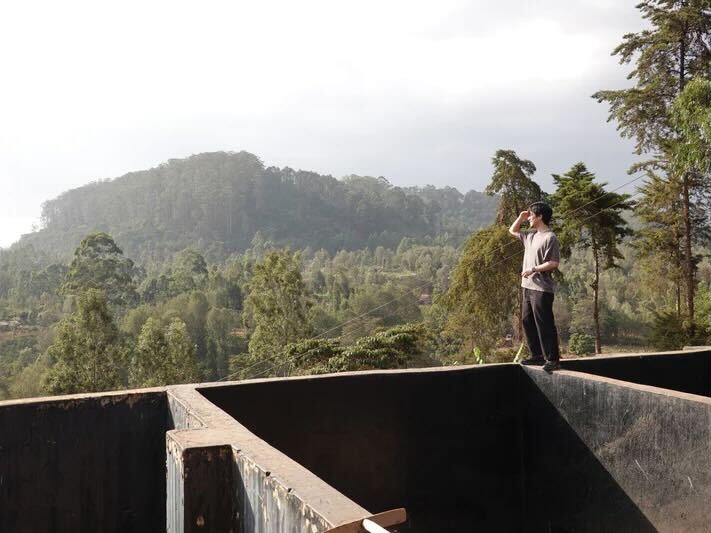
Origin Trip – Kenya 2023
table of contents
- First purchase at the production site since 2020
- Visit to exporter / Cupping for purchase
- Out turn
- Farm visit
- Factory visit

[Purchasing at the production site for the first time since 2020]
In late February of this year, I flew to Kenya and Ethiopia to purchase goods and inspect the production areas.
The borders that had been closed due to the pandemic were reopened, and this was the first time in three years that I was able to do full-scale local purchasing. It was also the first time in my life that I visited and purchased coffee in a coffee-producing region.
Because coffee is an agricultural crop, the harvest season varies depending on the region and climate where it is grown.
The main coffee-growing areas are close to the equator, in the so-called coffee belt, but because each region has a different harvest season, we roasters are able to provide fresh coffee beans all year round.
The main harvest season in Kenya is from October to January.
There is an earlier harvest period called the fly crop, but we always buy from the main harvest.
The coffee cherries are moved to the refinery as soon as they are harvested, so the refinery operates at full capacity from mid-October to January to process the coffee cherries that are delivered to it.
I visited Kenya in late February, and although the harvesting and processing season had ended, the buying season was in full swing, with roasters and buyers from trading companies from all over the world visiting to purchase coffee.

[Visiting exporters, purchasing and cupping]
After leaving Narita Airport and taking about a day, I arrived at Nairobi Airport in the afternoon local time. It was around 2pm and the temperature was 27°C. It was very dry in Kenya as it was the dry season, and the humidity was 0% according to the display on my smartphone.
We head from the airport into the city center on a highway that was just completed in 2020.
The scenery we saw from the car on the way from the airport to the city was much more urban than I had imagined, with skyscrapers and beautifully maintained parks. It seems that infrastructure development is progressing rapidly in Kenya.
In recent years, urban expansion has accelerated, and I've heard that many producers are selling off their farmland, resulting in a decrease in the area where coffee is produced.
The purpose of this visit is to purchase Kenyan coffee for this season.
During my stay, I visited two exporters and did cuppings. On the first day, I visited Dorman, and on the second day, I visited Ibero Kenya.
Note: An exporter that sells and exports green coffee beans to overseas buyers.

C.Dorman: Exporter founded in 1950 by Charles and Ellen Dorman
The coffee you can drink at the purchasing site is all fresh coffee that has just been harvested. When you think of fruits, you might imagine that the fresher they are, the tastier they taste, but coffee is a little different.
Cupping at the source is basically the same as cupping at a roaster or coffee shop, but the way the flavor is taken is different. First of all, since the coffee has just been processed, the flavor is often difficult to discern, and it is described as not having opened up, or the flavor and texture being rough.
Also, the roast may not be as deep as I am used to, and the water quality, grind size, temperature, etc. may not be perfect. In such an environment, I carefully evaluated and selected the coffee, judging its quality and flavor, and predicting (although this is impossible) how it would taste when it arrived in Japan and became a cup of coffee.
The Kenyan coffee that we usually roast and drink also has a strong acidity, but when it's fresh, it's even more sour. And when you're cupping more than 200 kinds of fresh Kenyan coffee all day, your mouth is numb by the end!

Second day at Ibero Kenya
[Out turn]
In Kenya, the first week of October is Week 1, when harvesting and processing at washing stations (called factories in Kenya) begin. We visited Kenya in Week 21. All coffee processed at the factory is given a lot identification number called an outturn. An outturn is like a micro lot that is divided according to the timing of harvest.
Coffee is sorted according to quality and harvest week, and even coffee processed in the same factory is strictly separated and managed.
Harvested and processed coffee continues to arrive from week 1 of October onwards, so exporters such as Dorman and Ibero Kenya roast large quantities of samples and cup them for quality evaluation every day.

10 sample roasters in full operation all day long
During the buying cupping, one person was quietly excited about the system of lot sorting and management by outturn. In Kenya, green beans are graded according to screen size and quality, such as AA and AB. These grades are selected after the beans are transferred to the dry mill after refining at the factory, but if the outturn is the same before the grading, it means that the same lot was refined in the same week.
This was the first time I had tried comparing AA and AB coffees from the same washing station that were refined in the same week, so it was a very refreshing experience. One of the highlights of this experience was being able to experience a taste that I would not normally be able to compare, and see how the taste of coffee differs depending on the grade. It was a small detail, but I was very excited during the cupping because I was happy to learn something new about coffee.
I think it's really amazing that in most coffee production sites in Kenya, lots are carefully selected and managed, from the time the farmers bring their coffee cherries to the time they are lined up on the cupping table.
Where was this coffee made and who made it?
This is a very important element for single origin coffee, but I felt like I could see the reason why Kenyan coffee is so delicious, in the fact that traceability is pursued thoroughly throughout the country, even in the finer details.

[Farm visit]
After the cupping is completed and the candidate lots are selected, we check how much we can purchase. After checking the lot that meets our requirements, we request a sample to finalize the order. Finally, we cup the sample again, and if there is no difference in quality, the purchase is confirmed.
After the cupping, we spent two days touring the factory while finalizing details such as the timing and method of export arrangements. Another highlight of this trip was visiting a coffee plantation for the first time in my life. I had seen evenly spaced coffee trees in books and on the Internet many times before, but walking between the trees and touching the leaves and cherries, I felt even more strongly that coffee is an agricultural product. It's a bit strange to think that the seeds of this fruit are roasted and drunk as coffee.
When I visited, most of the trees had already been harvested, so I wasn't able to see any ripe cherries, but there were some trees with small flowers in bloom, and I was able to enjoy their sweet jasmine-like scent. I'm sure the coffee plantation smells amazing when it's in full bloom. Just imagining it gets me excited.

Coffee Flower

An agronomist working at FCS who showed us around the farm
During the farm inspection, I was shown managed trees and trees that were left in their natural state. For example, the coffee trees that were not pruned were nearly 3 meters tall and thin, but most of the selected trees were about the same height as me (about 170 cm) and had sturdy branches growing from the bottom.
If selection is not done, coffee trees will become overgrown and light and air will not reach the entire tree. Therefore, trees with many leaves and branches will consume more energy to grow these parts, and they will not produce many flowers or fruits, which will reduce yields. Pests and diseases can also thrive in the dark, damp branches of densely packed trees.
Also, if coffee trees are left unattended, the yield will decrease year by year, so the upper branches of the tree need to be cut off every few years. At the farm we visited, we were told that this is done every six years. Then new trunks and branches will grow, and the tree will be able to produce a sufficient amount of fruit.

A coffee tree with the top part of the trunk cut off
[Factory Visit]
After visiting the farm, we toured some factories.
After the main harvesting work had been completed, there were some areas of the factory where staff were not present, but the managers were kind enough to help us out despite being on holiday, and we were grateful to be able to tour the factory.
The factory managers gave us a detailed explanation of the refining process, routines, and the equipment within the facility. They belong to the Farmers Cooperative Society, a producers' association, and act as managers selected by the members. In most factories, a manager is selected every two to three years, so the opinions of the staff seem to be respected. Some of them have been managers for nearly eight years, with strong leadership skills and the trust of the staff, and we could sense their strong passion for coffee production.
Managers closely monitor whether staff are following their guidelines and provide training to staff who need it.

Beatrice, the female factory manager

Efrim, manager of Ngunguru Factory

Charles, chairman of Kieni Factory
In Kenya, the refining process typically involves the use of disc pulpers to remove the skin and washing channels for gravity separation, which uses a lot of water.
Many of the factories get their water from nearby rivers, but some are struggling to secure water due to the effects of climate change.
In this context, with the introduction of eco-pulpers and other methods seen in Latin America, water recycling is gradually progressing and changes are being seen in coffee production.
When using the Eco Pulper, it appears that a larger amount of cherries can be processed in a day, and there appears to be an improvement in terms of productivity. 
Traditional disc pulper

The Penagos Ecopulper, a type found in Colombia and other countries, at the Gakuyuini Factory.
The basic processes and equipment were pretty much the same in each factory, but with so many cherries arriving every day, I think it is their commitment to strictly managing each process and striving to improve quality that makes Kenyan coffee so special.
On this trip, I purchased some fine Kenyan coffee.
The first release, AA Githembe, is available in stores and online.
We have several more Kenyan coffees to release in the future, so stay tuned.
Thank you for reading to the end.



